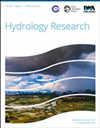第四纪不同沉积区地下水脆弱性评价的改进DRASTIC方法
IF 2.4
4区 环境科学与生态学
Q2 Environmental Science
引用次数: 2
摘要
DRASTIC方法是目前应用最广泛的地下水脆弱性评价技术之一。在主要有用的含水层被额外的不同沉积物层覆盖的地区,需要进一步修改DRASTIC方法以进行更精确的脆弱性估计。在具有多种第四纪沉积物对入渗条件影响显著的地区,对DRASTIC方法进行了改进。修改了三个参数:(1)调整了d参数,以考虑在某些情况下使含水层受到限制的上覆第四纪沉积物;(2)将s参数替换为第四纪沉积物类型参数,以评估高度变化的沉积物的水力特征;(3)将i参数替换为第四纪沉积物厚度参数,以描述从地表到主要有用含水层的距离。在爱沙尼亚中部一个有冰川沉积物的地区应用了原始和改进的DRASTIC方法。将DRASTIC方法和改进后的DRASTIC方法与爱沙尼亚以前的地下水脆弱性方法进行比较,结果表明DRASTIC方法有明显的改进,因此可以成功地应用于其他具有非均质第四纪沉积物覆盖特征的地区。本文章由计算机程序翻译,如有差异,请以英文原文为准。
Modified DRASTIC method for groundwater vulnerability assessment in areas with diverse Quaternary deposits
The DRASTIC method is one of the most widely used groundwater vulnerability assessment techniques. In areas where the main useful aquifers are covered with an extra layer of diverse sediments, a further modification of the DRASTIC method is required for a more precise vulnerability estimation. In this article, the DRASTIC method was improved in areas characterized by a layer of diverse Quaternary deposits remarkably influencing the infiltration conditions. Three parameters were modified: (1) the D-parameter was adjusted to consider the overlying Quaternary deposits that, in some cases, make the aquifer confined, (2) the S-parameter was replaced by the Quaternary sediment-type parameter to assess the hydraulic characteristics of the highly variable deposits, and (3) the I-parameter was replaced by the thickness of the Quaternary deposits parameter to describe the distance from the ground surface to the main useful aquifer. The original and modified DRASTIC methodology was applied in an area with glacial sediments in Central Estonia. Comparing the results using the original and the modified DRASTIC method to a former Estonian groundwater vulnerability method showed that the DRASTIC method was significantly improved and could, thus, be successfully applied in other areas characterized by a heterogenous Quaternary sediment cover.
求助全文
通过发布文献求助,成功后即可免费获取论文全文。
去求助
来源期刊

Hydrology Research
Environmental Science-Water Science and Technology
CiteScore
5.30
自引率
7.40%
发文量
70
审稿时长
17 weeks
期刊介绍:
Hydrology Research provides international coverage on all aspects of hydrology in its widest sense, and welcomes the submission of papers from across the subject. While emphasis is placed on studies of the hydrological cycle, the Journal also covers the physics and chemistry of water. Hydrology Research is intended to be a link between basic hydrological research and the practical application of scientific results within the broad field of water management.
 求助内容:
求助内容: 应助结果提醒方式:
应助结果提醒方式:


